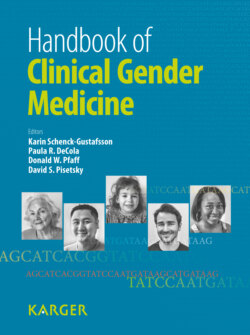Читать книгу Handbook of Clinical Gender Medicine - Группа авторов - Страница 19
Morbidity in Lesbian, Bisexual, Gay, Transgender, and Intersex Populations
ОглавлениеDisparities within LGBT populations as well as differences among them exist in relation to disease patterns and behaviors affecting health. A consistent disparity across LGBT populations is that they are at a higher risk for violence than the general population, with one third to one fourth of this population in the USA having experienced a violent act. Mental health is also an area of special concern, notably depression and anxiety [7, 8]. LGBT people are more than four times as likely to have attempted suicide as the general US population. Eating and body image disorders have a higher prevalence in gay and bisexual men compared to their heterosexual peers [7, 8]. It is believed that all of these mental health conditions are manifested as the result of being marginalized within society, coupled with a history of emotional or physical abuse [7, 8].
Additionally, higher rates of recreational drug use among gay men, higher rates of obesity among lesbians, and overall higher rates of tobacco use in LGBT populations have been reported in the USA and Canada and may result in increased morbidity [7, 8]. The use of tobacco puts this population at a higher risk for lung cancer and chronic obstructive pulmonary disease, obesity increases the risk of a number of non-communicable diseases, and finally recreational drug use can lead to an increased risk of sexually transmitted diseases due to an increase in high-risk sexual behaviors [7].
When we look at other areas of increased disease prevalence we see that lesbians are at a greater risk for morbidity and mortality due to gynecological cancers, especially ovarian cancers [7, 8]. This risk is thought to be compounded by the tendency to delay routine healthcare [7, 8]. Higher cancer risk is also seen in men who have sex with men. They have a higher prevalence of anal human papilloma virus which can result in anal cancer [7, 8].
There is little research on transgender morbidity but, due to exposure to hormone therapy over extended periods of time, transgender people may be at increased risk of hormone-related cancers [7, 8]. Special concern also exists regarding the self-administration of high-dose hormone regimens, without medical supervision, within the transgender population [15]. This practice poses an obvious and significant health risk.
